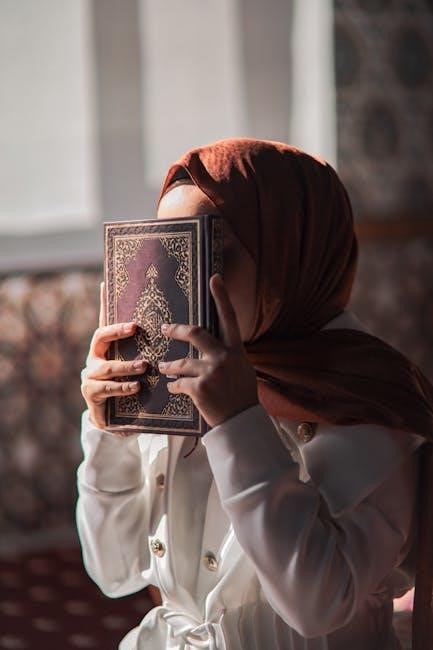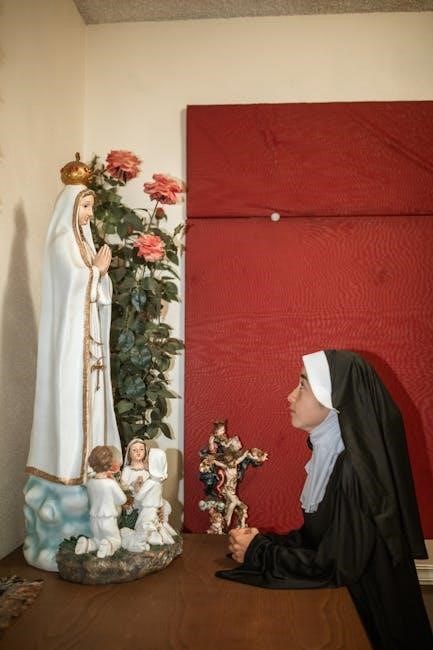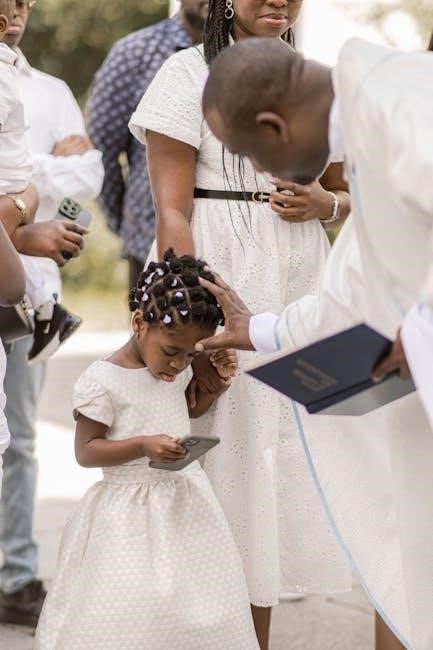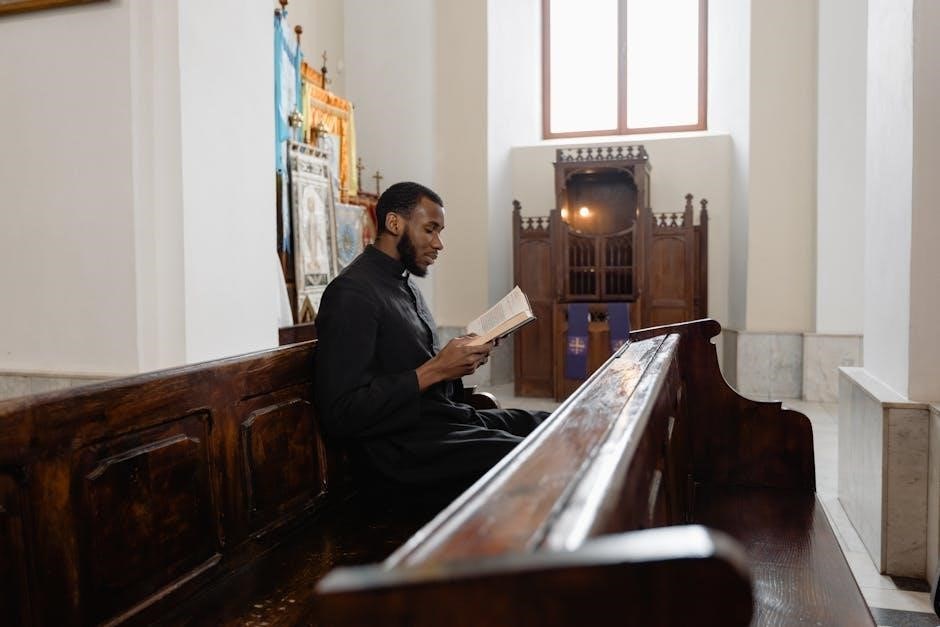The 40 Day Prayer for the Dead is a traditional practice honoring the deceased, rooted in faiths like Christianity and Judaism, offering rituals for the soul’s transition.
Overview of the Tradition
The 40 Day Prayer for the Dead is a deeply rooted tradition observed in various faiths, including Christianity and Judaism. It involves a structured period of mourning and spiritual devotion, aiming to guide the deceased’s soul through its transition. The practice includes daily prayers, recitation of the Holy Rosary, and litanies, often performed for 31 consecutive nights. These rituals are believed to offer comfort to the grieving and support for the soul’s purification. The tradition emphasizes the importance of communal and familial participation, fostering a sense of unity and shared faith. While specific customs vary across cultures, the core purpose remains consistent: to honor the departed and seek divine mercy for their eternal rest. This period is also seen as a time for reflection and spiritual growth for the living.
Significance of the 40-Day Period
The 40-day period holds profound spiritual significance, rooted in the belief that the soul transitions through purification before entering eternal rest. In many faith traditions, it is believed that the soul remains on earth for 40 days, seeking divine mercy and forgiveness. This period is considered crucial for offering prayers to aid the deceased in their journey. The 40-day prayer serves as a structured mourning practice, providing comfort to the grieving while supporting the soul’s purification. It is also seen as a time for the living to reflect on their own faith and seek spiritual growth. The tradition emphasizes the importance of communal prayer and devotion during this sacred period.

Significance and Background of the 40 Day Prayer
The 40 Day Prayer originates from religious traditions, offering a structured period of mourning and devotion to support the deceased’s soul and comfort the grieving.
Religious and Cultural Roots
The 40 Day Prayer for the Dead traces its origins to ancient religious practices, deeply rooted in traditions like Christianity and Judaism. In Christianity, particularly in Catholic and Orthodox faiths, this practice is linked to the belief that the soul undergoes purification before entering heaven. Many cultures worldwide have adopted similar rituals, reflecting a universal desire to honor and support the deceased during their transition. These practices also provide comfort to the grieving, fostering a sense of community and shared spiritual purpose. The historical roots of the 40-day period are tied to biblical accounts and cultural mourning customs, emphasizing the importance of prayer and remembrance.
The Purpose of the 40-Day Mourning Period
The 40-day mourning period is a sacred tradition dedicated to honoring the deceased and supporting their soul’s journey. It is believed that during this time, the soul transitions to the afterlife, and prayers offered by the living assist in this process. Families and communities come together to provide spiritual support, fostering a sense of unity and shared purpose. The practice also offers comfort to the grieving, helping them navigate their loss through structured rituals and reflections. This period emphasizes the importance of remembrance, ensuring the departed are not forgotten while their loved ones find solace in faith and prayer. It is a time of both mourning and hope, rooted in the belief that prayers can aid the soul’s purification and eternal rest.
Connection to the Afterlife and Purgatory
The 40-day prayer is deeply rooted in beliefs about the afterlife and purgatory, where the soul undergoes purification before entering eternal life. In many traditions, it is believed that the soul remains on earth for a period, seeking prayerful assistance from the living. This practice is particularly significant in Catholic and Orthodox traditions, where prayers are offered to aid the soul’s journey through purgatory. The 40-day period is seen as a critical time for intercession, ensuring the soul’s swift transition to heavenly rest. By praying for the deceased, the faithful provide spiritual support, reflecting their belief in the ongoing connection between the living and the dead. This tradition offers comfort to the grieving while emphasizing the importance of communal prayer in the soul’s purification process.

Structure and Content of the 40 Day Prayer
The 40 Day Prayer combines daily devotions, the Holy Rosary, and litanies, offering a structured approach to honor the deceased and support their spiritual journey.
Daily Prayers and Rituals
Daily prayers for the deceased typically begin with the Apostles’ Creed, followed by the Our Father, Hail Marys, and Glory Be. These prayers are recited for 31 consecutive nights, alongside the Holy Rosary and specific litanies, seeking divine mercy and pardon for the soul. The structured format ensures a consistent and dedicated approach, offering comfort to the grieving while supporting the soul’s journey. Many traditions include Novena prayers, which extend for a year after the initial 40 days, incorporating the Sorrowful Mysteries and additional devotional practices. This daily commitment strengthens faith and provides a sense of connection to the deceased.

The Role of the Holy Rosary
The Holy Rosary holds a central role in the 40 Day Prayer for the Dead, offering a structured and comforting ritual for the grieving. Each day, the Rosary is recited, often alongside the Sorrowful Mysteries, to seek divine mercy for the deceased. The repetition of prayers like the Hail Mary and Our Father creates a soothing rhythm, providing solace to those mourning. The Rosary is believed to assist the soul’s purification in purgatory, with each decade serving as a spiritual offering for their journey. Many families incorporate the Rosary into their daily prayers, fostering unity and faith during this period of remembrance. Its significance lies in its ability to connect the living with the deceased, offering hope and comfort through devout recitation.
Litanies and Other Devotional Practices
Litanies play a significant role in the 40 Day Prayer for the Dead, offering a structured form of supplication for the soul’s eternal rest. These prayers, often recited in repetition, invoke the intercession of saints and seek divine mercy for the deceased. Alongside litanies, other devotional practices include the recitation of Psalms, such as the De Profundis, and the use of novenas to prolong the prayerful vigil. These practices provide comfort to the grieving while emphasizing the belief in the soul’s journey toward purification. The inclusion of litanies and other devotional acts enriches the spiritual experience, fostering a sense of community and shared faith during the mourning period. They are integral to the tradition, offering solace and hope for both the living and the deceased.

Cultural Variations in the 40 Day Prayer
The 40 Day Prayer varies across cultures, with Christian traditions reciting litanies and attending Masses, while Jewish customs include recitations before Yom Kippur, reflecting diverse mourning rituals.
Christian Traditions (Catholic, Orthodox, etc.)
In Christian traditions, the 40 Day Prayer for the Dead is a solemn devotion, particularly in Catholic and Orthodox faiths. It involves daily prayers, Holy Rosary recitations, and litanies, often offered during Masses or at home. These prayers are believed to aid the soul’s purification in purgatory, seeking God’s mercy and eternal rest. The practice reflects the belief that the soul remains on earth for 40 days, transitioning to the afterlife. Many Christians also observe this period with Novenas and Sorrowful Mysteries, emphasizing communal support for the deceased and their grieving families. This structured mourning period strengthens faith and provides solace to those in bereavement.
Jewish and Other Faith Traditions
In Jewish tradition, the 40-day prayer for the dead is rooted in the belief that the soul transitions through stages of purification. Many Jews recite specific prayers, such as the Kaddish, during the 40-day period following burial, especially leading up to Yom Kippur. This practice reflects a deep respect for the departed and a communal effort to support their spiritual journey. Similarly, in other faiths, mourning periods often extend for 40 days, with unique rituals and prayers tailored to cultural and religious customs. These traditions emphasize the importance of honoring the deceased while offering comfort to the grieving. The 40-day period is widely seen as a sacred time for reflection and spiritual connection.
Regional Differences in Prayer Practices
The 40-day prayer for the dead varies significantly across regions and cultures. In some traditions, the prayer period is marked by daily recitation of specific psalms or liturgies, while others incorporate unique rituals. For instance, in Filipino Catholic traditions, the 40-day prayer often includes novenas and the Holy Rosary, reflecting a blend of faith and cultural practices. In Orthodox traditions, memorial services are conducted on the 40th day, emphasizing communal participation. Similarly, in Middle Eastern cultures, the prayer period may involve specific chants and readings. These regional differences highlight the diversity of mourning practices while maintaining the core intention of honoring the deceased and seeking divine mercy.

How to Perform the 40 Day Prayer
The 40-day prayer involves a structured framework of daily recitals, including the Holy Rosary, litanies, and specific prayers for the deceased, seeking divine mercy and peace.

Preparing for the Prayer Period
Preparing for the 40-day prayer begins with setting a dedicated space for worship, ensuring a quiet and reverent environment. Families often gather necessary prayer materials, such as the Holy Rosary, prayer books, and candles. It is essential to establish a consistent daily routine, committing to specific times for prayer to maintain discipline throughout the period. Many also reflect on the life of the deceased, sharing memories and stories to deepen their spiritual connection. Additionally, seeking guidance from religious leaders or community members can provide support and clarity during this solemn time. Proper preparation helps create a meaningful and focused experience for all participants.
Daily Commitment and Discipline
Maintaining a daily commitment is crucial for the 40-day prayer period, requiring discipline and dedication. Each day involves reciting specific prayers, such as the Holy Rosary, litanies, and the Our Father, to honor the deceased and support their soul. Consistency is key, as it reflects devotion and ensures the prayers’ effectiveness. Many find it helpful to establish a routine, praying at the same time each day to create a spiritual rhythm. This discipline not only aids in mourning but also strengthens faith and provides comfort to the grieving. By adhering to the daily structure, participants demonstrate their love and commitment to the departed, fostering a deeper connection throughout the 40-day journey.
Guidance for Families and Communities
The 40-day prayer period is often observed collectively by families and communities, fostering unity and shared spiritual support. Families are encouraged to gather daily for prayers, such as the Rosary or litanies, creating a comforting and structured routine. Communities can assist by organizing group prayers or providing resources like prayer guides and Novenas. Leaders or prayer coordinators can help ensure consistency and guide participants through the rituals. Sharing the responsibility of praying for the deceased strengthens bonds and eases the burden of grief. This collective effort not only honors the departed but also offers emotional and spiritual strength to those mourning, fostering a sense of togetherness and faith.

Prayer Resources and Downloads
The 40 Day Prayer for the Dead is supported by various resources, including free PDF downloads, structured prayer guides, and Novenas available online.
Free PDF Downloads Available Online
Numerous websites offer free PDF downloads for the 40 Day Prayer for the departed, providing structured rituals, daily prayers, Holy Rosary, litanies, and Novenas; These documents guide families in seeking mercy, pardon, and eternal rest for the deceased. They include traditional prayers, Sorrowful Mysteries, and concluding prayers. PDFs are easily accessible, allowing believers to honor their loved ones with devotion. These resources are invaluable for those seeking comfort and structure during the mourning period, ensuring the deceased’s soul is supported through prayer.
Structured Prayer Guides and Novenas
Structured prayer guides and Novenas are essential components of the 40 Day Prayer for the departed, offering a systematic approach to honor the deceased. These guides often include daily devotions, recitations of the Holy Rosary, and specific litanies aimed at seeking divine mercy and eternal rest for the soul. Novenas, which are nine-day cycles of prayer, are sometimes extended to span the 40-day period, intensifying the spiritual support for the deceased. Many resources also incorporate reflections and meditations, fostering a deeper connection with the departed and comforting the grieving. These structured formats ensure consistency and dedication, helping families and communities navigate the mourning process with faith and hope.

Recommended Prayers for Each Day
The 40 Day Prayer for the Dead often includes specific prayers recommended for each day to guide the soul toward eternal rest. These prayers, such as the Holy Rosary, litanies, and recitations of the Hail Mary and Our Father, are designed to seek divine mercy and pardon for the deceased. Many prayer guides suggest beginning with the Apostles’ Creed, followed by a series of prayers that reflect on the life and resurrection of Christ. Additionally, daily reflections and scriptural readings are often incorporated to deepen the connection with the departed and provide comfort to the grieving. These structured prayers offer a meaningful way to honor the deceased while fostering spiritual growth and hope for those who mourn.

Benefits of the 40 Day Prayer
The 40 Day Prayer offers spiritual growth, comfort for the grieving, and support for the deceased’s soul, strengthening faith and hope in eternal life.
Spiritual Comfort for the Grieving
The 40 Day Prayer provides profound solace to those mourning, offering a structured path to process grief. By engaging in daily rituals and recitals, individuals find emotional relief and spiritual strength. The practice fosters a sense of connection with the deceased, easing the pain of separation. It reminds the bereaved of eternal life and divine mercy, bringing hope and reassurance. This period of prayer helps transition from intense sorrow to peaceful acceptance, supported by faith and community. The repetitive nature of the prayers creates a comforting routine, allowing mourners to navigate their loss with grace and trust in God’s plan.
Support for the Deceased’s Soul
The 40 Day Prayer for the Dead is deeply rooted in the belief that the soul undergoes purification before entering eternal rest. This prayer tradition provides spiritual support to the deceased, seeking God’s mercy and pardon for their sins. By reciting specific prayers, such as the Holy Rosary and litanies, the faithful believe they assist the soul’s journey toward purification. The structured 40-day period is thought to coincide with the soul’s transition, offering comfort and guidance during this sacred time. This practice reflects a profound commitment to aiding the deceased in achieving eternal peace, emphasizing the importance of intercessory prayer for their liberation and rest.
Strengthening Faith and Hope
The 40 Day Prayer for the Dead serves as a powerful means of strengthening faith and hope for the grieving. By engaging in this structured prayer period, individuals find comfort in the belief that their loved ones are being guided toward eternal rest. The consistent recitation of prayers, such as the Holy Rosary and litanies, fosters a deeper spiritual connection and trust in God’s mercy. This practice also reinforces hope in the resurrection and the promise of eternal life, offering solace to those mourning. The communal aspect of these prayers further unites families and communities, providing emotional and spiritual support during a difficult time. Through this devotion, faith is renewed, and hope is revitalized, emphasizing the enduring bond between the living and the deceased.
The 40 Day Prayer for the Dead provides comfort, support, and a meaningful connection to the deceased, emphasizing faith and eternal hope.
The Enduring Importance of the 40 Day Prayer
The 40 Day Prayer holds profound significance as a comforting ritual for the grieving, offering solace and strengthening faith. It provides a structured way to honor the deceased, ensuring their soul is remembered and supported during the transition. This tradition fosters a sense of community, as family and friends unite in prayer, sharing in both sorrow and hope. By focusing on mercy, forgiveness, and eternal rest, the prayer reinforces belief in the afterlife and God’s compassion. Its enduring importance lies in its ability to guide the living through mourning while offering spiritual upliftment to the departed. This practice remains a timeless expression of love, faith, and connection.
Final Thoughts and Encouragement
Embracing the 40 Day Prayer for the Dead offers a meaningful way to honor loved ones and find spiritual comfort. This practice, rooted in tradition, guides the soul through its journey, providing solace to the grieving; By committing to daily prayers and rituals, individuals strengthen their faith and foster a deeper connection with the deceased. It’s a powerful reminder of the enduring bond between the living and the departed. Encouraging others to participate can create a supportive community, ensuring the deceased are remembered with love and care. May this practice bring hope, peace, and reassurance of eternal rest for the departed.
